
|
| |
|
|
|
|
 |
|
|
T-34 History Part III
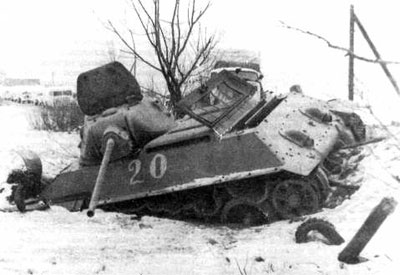 |
T-34 History
Part III
Part I... Part II...
T-34/57 Tank Hunter
As early as 1940 the Soviets saw the need for a more powerful anti-tank gun than the current 45mm weapon. The first prototype of the 57mm gun was completed in September 1940, but manufacturing of the new gun was delayed while priority was given to the new F-34 76mm tank gun for the T-34.
|
Above: T-34/57 obr 1941: you can just make out the ring fitted into the mantlet to fit the slimmer 57mm ZIS-4 gun barrel.
In December 1940 the first 57mm gun for mounting in a tank was manufactured and then spent until March 1941 in factory trials. In April 1941 it was mounted on a production T-34 obr 1941 and sent for field trials. The new 57mm ZIS-2 gun proved to have a very short barrel life and low accuracy. It was sent back to the factory for further design improvements.
|
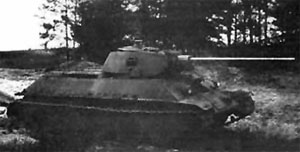 |
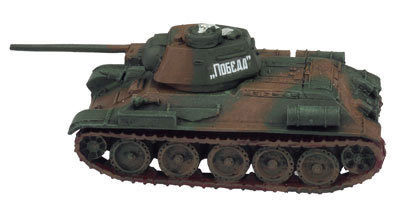 |
The new improved gun, the ZIS-4, was mounted in a T-34 and once again sent for field-testing where it was approved for manufacture. The intent was to arm some T-34s in a company with the ZIS-4 57mm gun as tank-hunters, and not the replace the F-34 76mm gun that had proved its worth as duel purpose high explosive/anti-tank weapon.
Mast production started in August 1941, but after a short run had been completed it was cancelled in December 1941 because of a shortage of 57mm ammunition. 133 ZIS-4 guns had been manufactured. 21 guns were used at the Kharkov plant, 20 at Stalingrad and unknown number at Krasnoye Sormovo.
|
T-34/57 obr 1941s were used in combat in the defensive of Moscow. 21 were used by the 21st Tank Brigade and 8 by the 8th Tank Brigade.
In 1943 development and production of the 57mm gun resumed when it was realised that the 45mm and 76mm guns in current use were no longer able to combat the German’s heavier tanks. A new batch of T-34/57 tanks were prepared, armed with the improved ZIS-4M 57mm gun. The gun now shared the same simplified breach as the F-34, ZIS-2, ZIS-3 and ZIS-5 guns. Initial they new T-34/57s were issued with an improved anti-tank round, but this proved hard on the barrels and was with drawn after a short time.
The second generation of T-34/57 saw service in the same tank-hunter role as their first incarnation and first went into action in August 1943.
Factory #92 made 192 ZIS-4Ms in 1943 before switching production to the 85mm gun in 1944.
The T-34/57’s short reign was ended with the introduction of the T-34/85 in 1944. The new 85mm gun had better anti-tank performance than the ZIS-4M and retained an excellent high explosive round, unlike the ZIS-4M who’s HE round often proved ineffective.
|
|
SU-122
In April 1942 several Soviet design bureaus were ordered to design an armoured assault gun mounting 122mm or greater weapon. The most successful design to emerge from this process came from the Uralsky Machine-Building factory, designated U-35. This design was to go on to become the SU-122, and it was adopted, after extensive trials, in December 1942.
The first 25 were manufactured by the end of the year. By March 1943 four regiments were quipped with the SU-122.
|
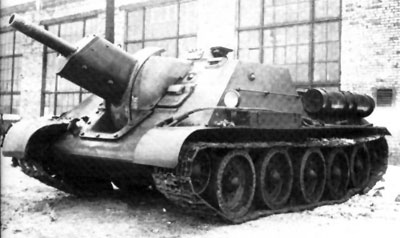 |
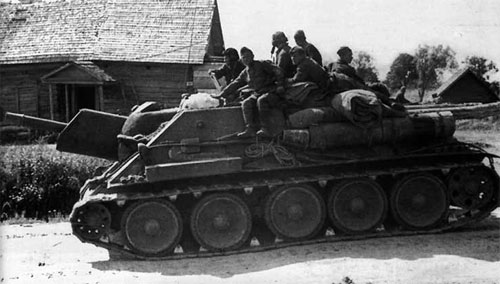 |
It was armed with the 122mm M-30 howitzer and the vehicle was based on the chassis of the successful T-34 medium tank.
It was crewed by five men; a driver, a gunner (stationed to the left behind the driver), a commander (right front) and the two loaders (the M-30 was loaded with two part ammunition) were behind the howitzer’s breech.
|
|
Right: A SU-122 crew take a break to get their bearings.
The 122mm gun proved to be good for both close
support work and anti-tank, it’s high explosive round often proving
enough to knock out enemy tanks with the sheer concussive effect.
Towards the end of the production run, SU-122s were built with the same ball mantlet as the later SU-85s. SU-122 production continued into the summer of 1944, by that time over 1100 had been made.
|
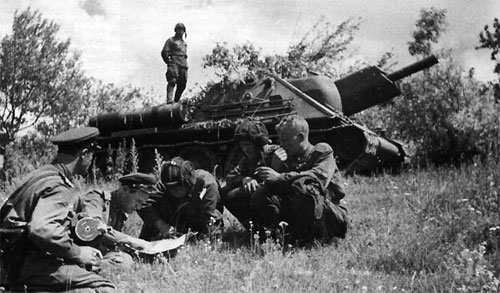 |
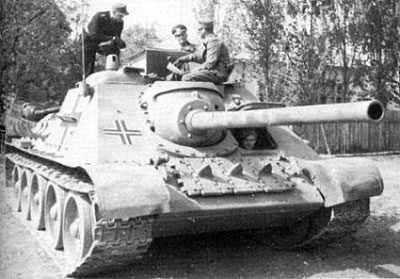 |
SU-85
In January 1943 the Soviets captured a new German Tiger IE near Leningrad. On inspection they were quite disturbed by the thickness of the Tigers armour.
They tested various guns against it’s armour, discovering the 76mm guns of the T-34 and KVs next to useless, the M-30 howitzer of the SU-122 marginal and the only two guns proving of any effect were the 85mm anti-aircraft gun and 122mm A-19 Corps gun.
It was decided to mount the 85mm gun on a modified SU-122 hull. They used the already modified S-18 guns as developed for the KV-85. This was the SU-85-I.
|
After initial attempts to mount the gun straight into the SU-122 made the fighting compartment too cramped, because the 85mm gun breach proved too long, it was decided to redesign the layout of the hull.
Still retaining the SU-122 hull as the basic starting point the mantlet was extended forward to allow more space in the fighting compartment for the crew, this model was known as the SU-85-IV.
While the above models were under development another version was being developed mounting the D-5S 85mm gun.
|
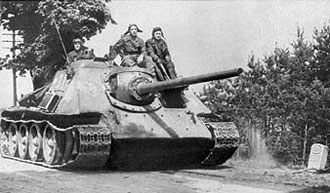 |
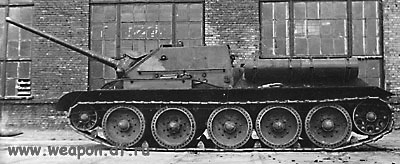 |
This proved just as good against armour and more reliable in field-testing.
Thought initially it didn’t mount a telescope, one was soon fitted and this became the SU-85-II.
After further trials it was decided to adopt the SU-85-II as the superior design, it was designated the Self-propelled Anti-tank Gun SU-85.
|
|
The SU-85 had an armoured commanders “cap” fitted with vision equipment.
The Dnieper crossing, in September 1943, saw the very first use of the
SU-85. In combat the SU-85 proved a great asset with its powerful gun
able to penetrate German Tigers and Panthers from quite long ranges.
2329 SU-85s were built.
With the introduction of the SU-100, the SU-85s production was halted in July 1944. But a shortage of 100mm ammunition saw a limited run of 315 SU-100 hulls fitted with 85mm guns (July to September 1944). These were known as SU-85M.
|
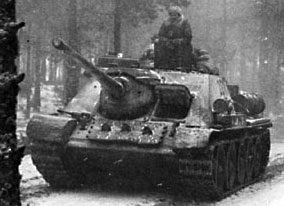 |
Last Updated On Thursday, December 18, 2008 by Wayne at Battlefront
|
|
|